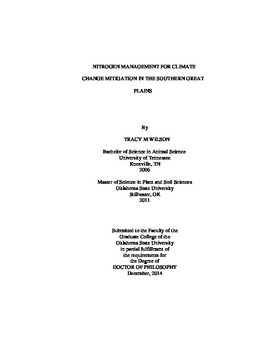| dc.contributor.advisor | Warren, Jason | |
| dc.contributor.author | Wilson, Tracy M. | |
| dc.date.accessioned | 2016-01-20T15:45:10Z | |
| dc.date.available | 2016-01-20T15:45:10Z | |
| dc.date.issued | 2014-12 | |
| dc.identifier.uri | https://hdl.handle.net/11244/25735 | |
| dc.description.abstract | Nitrous oxide (N2O) is a potent greenhouse gas (GHG), with a global warming potential 310 times that of carbon dioxide (CO2). Agricultural soil management in the U.S. is responsible for 69% of N2O emissions. Fertilizer induced N2O emissions (the difference between fertilized and unfertilized soil) are estimated to be 1.25 plus or minus 1.0% of N applied to agricultural fields. Cellulosic biofuel has been promoted as a method of reducing GHG emissions from the combustion of fossil fuels. However, there is little data available to evaluate N2O emissions from biofuel feedstock production such as forage sorghum and switchgrass. Therefore a study was conducted in Stillwater, OK to measure N2O emissions from the potential biofuel feedstocks; forage sorghum, switchgrass, and mixed grasses over 3 years. There are few studies examining the basic effects of N fertilization on N2O emissions from dry land winter wheat in semi-arid environments. The southern Great Plains of the U.S. has no data evaluating the impact of N application rate on N2O emission from winter wheat. Thus, this winter wheat production area, representing 20.9 million acres is not represented within global N2O emission estimates used by the IPCC. Therefore, a study was established in a long term continuous winter wheat fertility experiment in Stillwater, OK to determine the effects of N rate on N2O emissions from dry land winter wheat in the southern Great Plains of the U.S. in order to fill this knowledge gap. Legume cover crops have been used to fix N from the atmosphere and have been suggested as a method to reduce N fertilizer inputs. Little research has been focused on evaluating the use of cover crop mixtures. Therefore a study to evaluate the impacts of using leguminous cover crop mixtures on N cycling, soil moisture, and cash crop performance in continuous no till winter wheat production was established in 2013. Emissions of N2O are highly variable and depend greatly on climatic conditions and are influenced by N fertilization. Cover crops did not impact wheat yields, and cover crop mixtures with grass species as a component reduced soil NO3 levels more than legume only mixtures. | |
| dc.format | application/pdf | |
| dc.language | en_US | |
| dc.rights | Copyright is held by the author who has granted the Oklahoma State University Library the non-exclusive right to share this material in its institutional repository. Contact Digital Library Services at lib-dls@okstate.edu or 405-744-9161 for the permission policy on the use, reproduction or distribution of this material. | |
| dc.title | Nitrogen management for climate change mitigation in the southern Great Plains | |
| dc.contributor.committeeMember | Arnall, Daryl Brian | |
| dc.contributor.committeeMember | Kakani, Gopal | |
| dc.contributor.committeeMember | Goad, Carla Lynn | |
| osu.filename | Wilson_okstate_0664D_13714.pdf | |
| osu.accesstype | Open Access | |
| dc.type.genre | Dissertation | |
| dc.type.material | Text | |
| thesis.degree.discipline | Soil Science | |
| thesis.degree.grantor | Oklahoma State University | |
